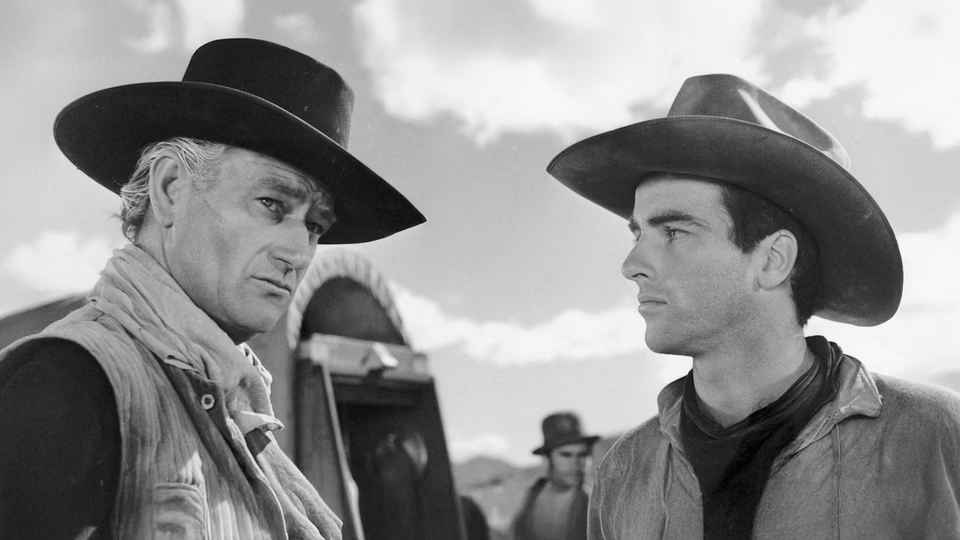Red River

Howard Hawks’ Red River stands as one of the great American westerns, a film that transforms the simple premise of a cattle drive into a profound meditation on power, legacy, and the clash between generations. Here, John Wayne delivers what may be his most complex performance, playing Thomas Dunson not as the heroic figure we expect, but as a man whose determination curdles into dangerous obsession.
The story follows Dunson, a cattle baron facing financial ruin after the Civil War, as he leads a massive herd north to the Missouri railroads. What begins as an act of salvation becomes a descent into tyranny, as Dunson’s desperation transforms him into a monster. Montgomery Clift, in his film debut, plays Matt Garth, Dunson’s adopted son, whose growing opposition to his father’s methods drives the film’s central conflict.
Wayne’s performance anchors the film. Rather than the stalwart hero of his Ford collaborations, Dunson is a man we understand without necessarily sympathizing with. His journey from pioneer to despot feels inevitable, born from a middle-aged man’s recognition that he lacks the time to rebuild what he’s spent decades creating. Clift provides the perfect counterpoint—young, idealistic, with a future that stretches before him like the endless prairie. It’s a generational divide made flesh.
Hawks stages the cattle drive with remarkable authenticity. Hundreds of cattle surge across the screen, kicking up dust clouds that hang in the air like fog, creating a visceral sense of the undertaking’s scale. The stampede sequence ranks among the most thrilling ever filmed, conveying both the raw power of spooked cattle and the mortal danger they represent. When the drive fords the Red River itself, Hawks places us inside a wagon as it dips into the water, making us feel the weight and risk of the crossing.
The film’s production values shine throughout, though Hawks’ attempt to blend location and studio work doesn’t always succeed. The soundstage sequences, particularly an early Indian attack, feel artificial against the sweeping authenticity of the location photography. His mid-pan attempts to bridge the two environments only highlight the disparity.
Joanne Dru arrives late but makes a powerful impression as Tess Millay, embodying the archetypal Hawksian woman. When we first meet her during an Indian raid, she takes an arrow in the shoulder while reloading rifles and barely flinches. Her later confrontation with Dunson crackles with tension, as she matches his intensity without surrendering her composure. It’s a performance that draws a direct line to Hawks’ later heroines in Rio Bravo and influenced filmmakers like John Carpenter.
Walter Brennan delivers another memorable turn as Groot, Dunson’s loyal companion. His transformation from the film’s opening to its conclusion is remarkable – he literally appears to age ten years, prefiguring his look in Rio Bravo over a decade later. Harry Carey, the silent western star, provides a stirring final performance as the drive’s salvation, though he died before the film’s delayed release.
The script proves the film’s weakest element, suffering from clunky transitions and predictable character beats. An early sequence where Wayne declares his intention to build an empire, followed by a montage and his return with the line “Well, we’ve had our ten years,” feels mechanical. The film also relies too heavily on tired tropes—when a character announces his plan to buy red shoes for his wife with his earnings, his doom is sealed.
Yet these flaws pale against the film’s achievements. Red River succeeds as both spectacular entertainment and character study, exploring themes that would define the western genre for decades. The final confrontation between Wayne and Clift gains power from Hawks’ decision to wound the older man first, leveling the playing field and forcing us to confront our sympathies.
Dimitri Tiomkin’s score provides stirring accompaniment to the action, while the somber theme “Settle Down” offers meditative counterpoint—a theme he would recycle with new lyrics for Rio Bravo as “My Rifle, My Pony, and Me.”
Red River represents Hawks and Wayne at their most ambitious, crafting a western that questions the very myths it appears to celebrate. It’s a film about the cost of empire-building, the weight of legacy, and the inevitable moment when the old must yield to the new. In Thomas Dunson, Wayne created one of his most memorable characters—not a hero, but a man whose heroic qualities become his tragic flaws.